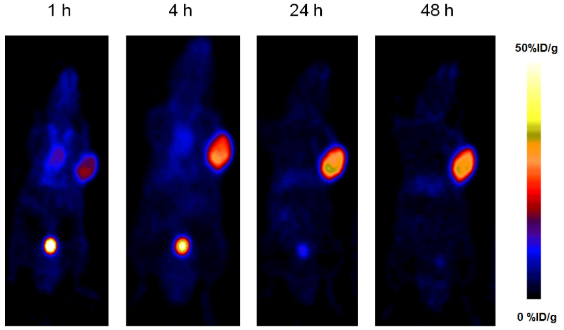Several radioligands that target PSMA have been clinically introduced as a new class of theranostics for prostate cancer diagnosis and therapy. One of them, methyl cysteine-glutamate urea (MCG), has been labeled successfully with both fluorescent dyes and radioisotopes for prostate cancer imaging.
For this study using a mouse model, MCG was conjugated with an albumin-binding Evans blue (EB) derivative to further improve tumor delivery and increase the therapeutic effect. Albumin, the most abundant plasma protein in human blood, is a natural transport protein and has a long circulatory half-life.
“Albumin-based drug delivery systems play a very important role in the treatment of diabetes and are also expanding to the field of oncology,” explains Zhantong Wang, corresponding author and a researcher at the U.S. National Institute of Biomedical Imaging and Bioengineering.
The study used yttrium-86 (86Y)-DOTA-EB-MCG for positron emission tomography (PET) imaging performed at 1, 4, 24 and 48 hours post injection to evaluate biodistribution and tumor uptake. DOTA-EB-MCG was then labeled with yttrium-90 (90Y) for the radioligand therapy.
Administration of a 3.7 MBq dose of 90Y-DOTA-EB-MCG resulted in significant tumor growth inhibition, and when a single 7.4 MBq dose of 90Y-DOTA-EB-MCG was used, the tumors were completely eradicated, with no apparent associated toxicity or weight loss. In comparison, a 7.4 MBq dose of 90Y-DOTA-MCG only showed a marginal delay of tumor growth. Modification of MCG with the EB derivative, therefore, resulted in a highly efficient prostate cancer-targeting agent in mice.
Wang notes, “With the incorporation of EB, binding with albumin will usually extend the circulation time of the radioligands, resulting in an increased time frame for them to interact with the PSMA receptors. Additionally, the relatively large size of the albumin-radioligand complex will facilitate tumor accumulation via enhanced permeability and retention. Furthermore, additional internalization of the radioligand may be mediated by albumin-binding proteins, such as the gp60 receptor, which are overexpressed in tumor cells.” He concludes, “All these findings strongly suggest radioligand therapy using albumin-binding moieties is a promising strategy in cancer management. Additional study is required to determine its effectiveness in humans.”

FIGURE: Longitudinal PET imaging with 86Y-DOTA-EB-MCG. Imaging at 1, 4, 24, and 48 hours post-injection of 86Y-DOTA-EB-MCG shows tumor uptake. Credit: Z Wang et al., National Institutes of Health, Bethesda, MD
Abstract 2: “An Improved Prostate Specific Membrane Antigen Targeting Agent for Prostate Cancer Imaging and Therapy,” Zhantong Wang; Orit Jacobson; Rui Tian; Dale O. Kiesewetter, PhD; Gang Niu, MD, and and Xiaoyuan Chen, PhD, National Institutes of Health (NIH), Bethesda, MD; Ronnie C. Mease, PhD, Johns Hopkins University, Fairfax, VA; Martin G. Pomper, MD, PhD, Johns Hopkins Medical Institutions, Baltimore, MD, SNMMI’s 65th Annual Meeting, June 23-26, Philadelphia, PA.


